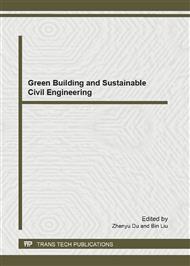[1]
Jun Chen, Chi-sun Poon. Photocatalytic construction and building materials: from fundamentals to applications, Building and Environment, Vol. 44 (2009), p.1899–(1906).
DOI: 10.1016/j.buildenv.2009.01.002
Google Scholar
[2]
L. Cassar, Photocatalysis of cementitious materials: clean buildings and clean air, MRS Bulletin, Vol. 29 (2004), p.328–331.
DOI: 10.1557/mrs2004.99
Google Scholar
[3]
Poon CS, Cheung E. NO removal efficiency of photocatalytic paving blocks prepared with recycled materials. Construction and Building Materials, Vol. 21(2006), p.1746–53.
DOI: 10.1016/j.conbuildmat.2006.05.018
Google Scholar
[4]
Beeldens A. Air purification by road materials: results of the test project in Antwerp. In: Baglioni P, Cassar L, eds. RILEM Int. Symp. On photocatalysis, environment and construction materials. Italy, Vol. (2007), p.187–94.
Google Scholar
[5]
Husken G, Hunger M, Brouwers H. Comparative study on cementitious products containing titanium dioxide as photo-catalyst. In: Baglioni P, Cassar L, eds. RILEM Int. Symp. On Photocatalysis, environment and construction materials. Italy, Vol. (2007).
Google Scholar
[6]
QIAN Chun-xiang, ZHAO Lian-fang, WANG Rui-xing. Effect of concentration of nitrogen oxidizes on photocatalytic oxidation efficiency of nano TiO2 photocatalyst immobilized on cement-based material. Materials Science&Technolog, Vol. 15 (2007).
Google Scholar
[7]
QIAN Chun-xiang; ZHAO Lian-fang; FU Da-fang; LI Li; WANG Rui-xing. A simulated study on the photocatalysis dynamics of nano TiO2 supported on the cement-based materials. Journal of Safety and Environment, Vol. 5 (2005), p.60–64.
Google Scholar
[8]
QIAN Chunxiang; ZHAO Lianfang; FU Dafang; LI Li; WANG Ruixing. Photocatalytic oxidation of nitrogen oxides by nano- TiO2 immobilized on road surface materials, Journal of The Chinese Ceramic Society, Vol. 33 (2005), p.422–427.
Google Scholar
[9]
Guan Qiang, Chen Meng, Study on Decontamination of Vehicle Emissions by Nano-TiO2 Sprayed on Highway Concrete Pavement, Journal of Highway and Transportation Research and Development, Vol. 10 (2009), pp.154-158.
Google Scholar
[10]
Chen Meng, Han Xiangchun, You Tiexue, Influencing Factors of TiO2 Photocatalytic Oxidation on Pollutant Dispersion of Motor Vehicle, Journal of Northeast Forestry University, Vol. 6 (2006), pp.70-79.
Google Scholar
[11]
M. Chen, Y.H. Liu, NOx removal from vehicle emissions by functionality surface of asphalt road, Journal of Hazardous Materials, Vol. 174 (2010), p.375–379.
DOI: 10.1016/j.jhazmat.2009.09.062
Google Scholar
[12]
Chen Meng, Chu Jiangwe, Preparation of Photochemical Catalysis Environmental Protection Material for Highway Asphalt Surface and Its Purification Function, Journal of Northeast Forestry University, Vol. 5 (2010), pp.142-144.
Google Scholar
[13]
Crispino M., Lambrugo S, Venturini L, A real scale analysis of surface charactristics of a photocatalytic pavement, 4th international siiv congress- palermo (italy), Vol. (1992), pp.355-366.
Google Scholar
[14]
G.L. Guerrini, E. Peccati, Photocatalytic cementitious roads for depollution, in: P. Baglioni, L. Cassar (Eds. ), Proceedings international RILEM symposium on photocatalysis, environment and construction materials-TDP 2007, RILEM Publications, Bagneux, (2007).
Google Scholar
[15]
Maggos T, Plassais A, Bartzis JG, Vasilakos C, Moussiopoulos N, Bonafous L. Photocatalytic degradation of NOx in a pilot street canyon configuration using TiO2-mortar panels. Environmental Monitoring and Assessment, (2008), p.35–44.
DOI: 10.1007/s10661-007-9722-2
Google Scholar
[16]
Akira Fujishima, Xintong Zhang, Donald A. Tryk, TiO2 photocatalysis and related surface phenomena. Surface Science Reports, Vol. 63 (2008), pp.515-582.
DOI: 10.1016/j.surfrep.2008.10.001
Google Scholar
[17]
Yu CM. Deactivation and regeneration of environmentally exposed titanium dioxide (TiO2) based products. Environmental Protection Department, HKSAR 2003; Departmental Order Ref. No: E183413.
Google Scholar
[18]
Bygott CE, Maltby JE, Stratton JL, McIntyre R. Photocatalytic coatings for the construction industry. In: Baglioni P, Cassar L, eds. RILEM Int. Symp. On photocatalysis, environment and construction materials. Vol. (2007), p.251–258.
Google Scholar
[19]
Wang JX, Chen CY, Liu Y, Jiao F, Li W, Lao F, et al. Potential neurological lesion after nasal instillation of TiO2 nanoparticles in the anatase and rutile crystal phases. Toxicology Letters, Vol. 183 (2008), p.72–80.
DOI: 10.1016/j.toxlet.2008.10.001
Google Scholar


